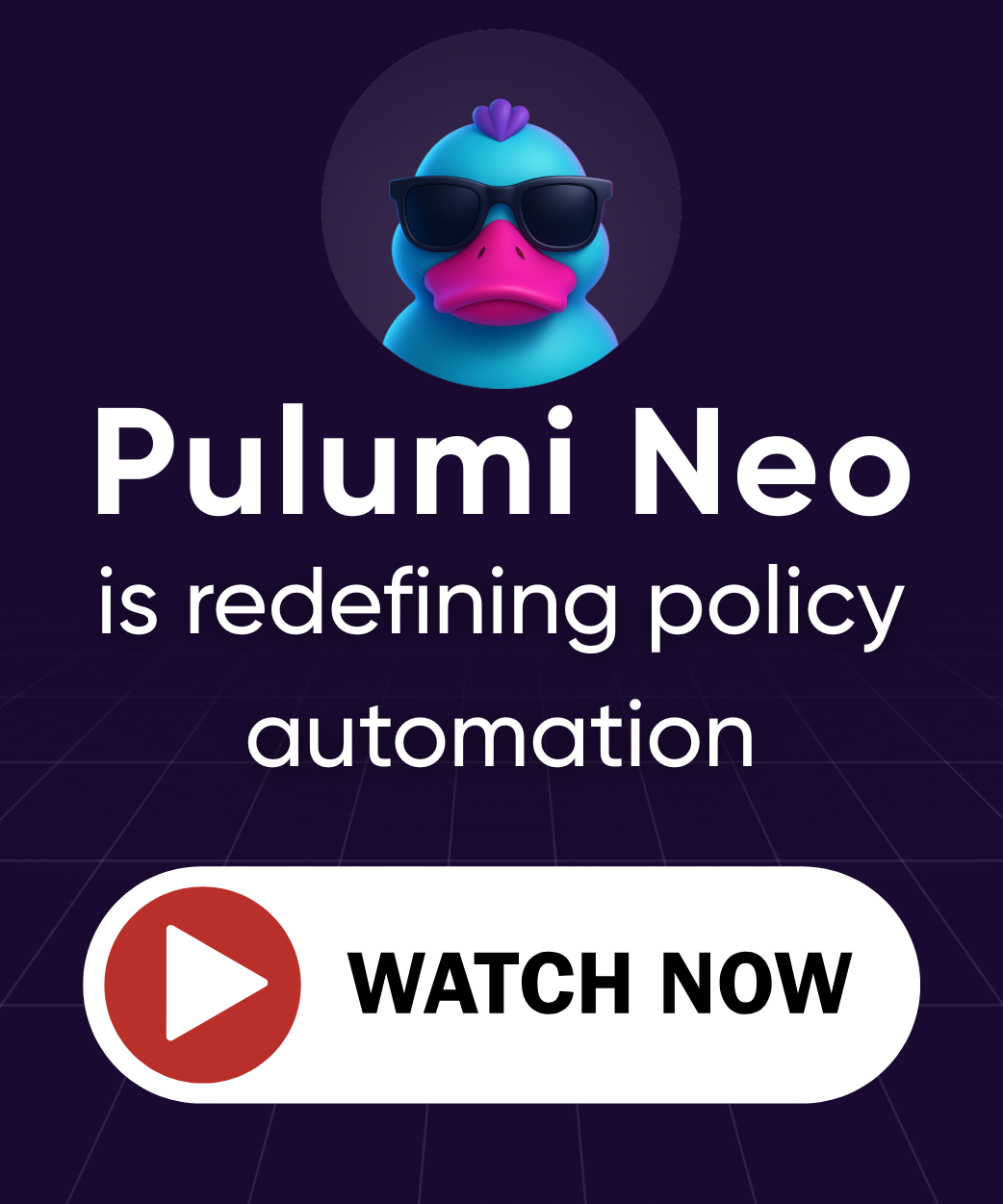Why Choose Pulumi Cloud Over DIY Backends?
Posted on
Pulumi Cloud empowers engineers to automate, secure, and manage modern infrastructure platforms.
Many companies are building internal developer platforms or modern infrastructure platforms to provide developer self-service while maintaining security and compliance. Companies adopt Pulumi IaC so they can apply software engineering practices to their infrastructure scaling problems and because it is fully open source with a strong community and public roadmap.
At Pulumi, we’re committed to open source—always have been; always will be. Pulumi IaC is entirely open source (Apache 2.0 license), meaning you can adopt and extend it however you like. If you’re new to Pulumi, the open source edition is an excellent way to start modernizing your infrastructure. But as your organization grows and the complexity of your environment increases, you may find yourself devoting significant time to rolling your own enterprise IaC backend features.
That’s why we built Pulumi Cloud—to help you avoid building and maintaining these capabilities from scratch while ensuring you can automate, secure, and manage your infrastructure at scale. Pulumi Cloud provides enterprise capabilities that make it easier to build modern infrastructure platforms. Companies receive increasing value from Pulumi Cloud as their organization and their infrastructure platforms grow in size and complexity.
As companies expand or platform engineering mandates become more expansive, challenges arise around collaboration, security, governance, and scaling. Some questions that need answering include:
- How do teams collaborate?
- How do you securely manage infrastructure state?
- How do you enable self-service infrastructure?
- How do you adhere to IT security standards?
- How do you enforce governance policies?
- How do you protect sensitive data?
- How do you enforce least privileged access across the organization?
- How do you maintain uptime or get support for your architecture?
- How do you manage the cost and complexity of multi-cloud environments?
If some of these questions apply to you or your team, learn more about Pulumi Cloud below to understand when it makes sense to transition to a paid Pulumi offering.
What drives the most value in Pulumi Cloud?
The most frequent business values that our existing customers experience with Pulumi Cloud relate to speed, scale, security, and savings.
Speed
There are speed benefits that customers typically experience across three areas: the infrastructure platform, developer productivity, and operations. Pulumi Cloud simplifies building and running complex infrastructure automation workflows through the Automation API. It also makes it easy to componentize best practices that can be easily shared and distributed through a centralized repository.
Pulumi Cloud streamlines the software delivery pipeline with Pulumi Deployments and a wide range of 3rd party CI/CD integrations.
Pulumi Cloud provides Pulumi Insights, offering search, analytics, and AI-driven insights over your infrastructure. With Insights, you can instantly search for critical information - such as finding MySQL databases on end-of-life versions across all your cloud assets, reducing the operational time it takes to find needles in haystacks.
Scale
Part of building an infrastructure platform is so your organization can scale and make it easy to onboard new developers. Pulumi Cloud integrates seamlessly with various identity providers like Azure ActiveDirectory, Okta, G Suite, or any SAML/SSO provider, offering deep support for role-based access control (RBAC) and SCIM for automatic synchronization and revocation of access based on identity provider groups. Audit logs keep track of developer activity within an organization, recording what actions were taken, when, and by whom.
Pulumi Cloud also makes it easy to build developer portals for developer self-service. Organization Templates can provide a centralized repository for cloud components, best practices and configurations. The New Project Wizard also provides a gallery interface to pick a template and easily walk through configuration and deployment of the infrastructure.
Security
Another reason your organization is investing in an infrastructure platform is so that security and compliance can be automated as infrastructure is self-serviced. Your platform must prevent infrastructure deployments that violate security, reliability, cost, or compliance policies. Pulumi Cloud, through Pulumi CrossGuard, provides out-of-the-box support for common security and compliance policies, ensuring PCIDSS, ISO27001, SOC2, and CIS compliance for cloud applications and infrastructure.
For applications being built across the organization, securing sensitive information like database passwords, cloud credentials, and API keys is paramount. Secrets can inadvertently end up in insecurely stored state files, leading to potential breaches. Pulumi Cloud, however, encrypts all data in transit and at rest, utilizing hardware security module (HSM) based encryption. Read the Pulumi Cloud Security Whitepaper for more information.
Pulumi Cloud further enhances security with Pulumi ESC, a centralized secrets management and orchestration service. This service pulls and syncs secrets from various stores like HashiCorp Vault, AWS Secrets Manager, Azure Key Vault, GCP Secret Manager, and 1Password, making it easy to adopt dynamic, short-lived secrets on demand. Secrets can be accessed via CLI, API, Kubernetes operator, the Pulumi Cloud UI, and in-code with TypeScript/JavaScript, Python, and Go SDKs. Pulumi ESC leverages the same identity, RBAC, Teams, SAML/SCIM, OIDC, and scoped access tokens used by Pulumi IaC, ensuring that secrets management complies with enterprise security policies.
Savings
Building a platform and managing cloud infrastructure demands considerable time and energy. As discussed above, Pulumi Insights X-Rays your entire cloud footprint, so you can observe, plan, and drive changes across your infrastructure. With this total visibility, Pulumi Insights helps you reduce waste by showing you usage information and identifying potentially stale infrastructure, which can lead to substantial cost savings.
You can also have a conversation with Pulumi Copilot about your infrastructure in natural language and get answers to operational questions that would take hours to piece together from other sources.
Why not build your own enterprise features on top of Pulumi IaC open source?
Build vs buy is a question of opportunity cost. Should you and your team build and operate your own enterprise backend service that engineers at Pulumi have already built to handle the needs and scale of the world’s biggest companies? Or is their time better spent focused on building a modern infrastructure platform that will increase development velocity across the company and drive business growth?
Maintenance costs
When you build and operate your own enterprise backend, you’ll need to dedicate one full-time engineer for every team of ten - that’s nearly 10% of your engineering expense. Running a backend requires maintenance, updates, and troubleshooting. Outages and incidents can lead to significant financial losses. Pulumi Cloud, as a fully managed service, frees up your team’s time from the operational and maintenance burdens of managing an IaC backend.
Operational reliability and availability
One of the primary functions of the enterprise backend is managing state. State management involves managing concurrency controls, preventing state corruption, ensuring backup and recovery, maintaining high availability of the state service, and providing consistent visibility across all managed resources; this is easy to get wrong. Manual human intervention is frequently required to recover and repair state files, a process that is time-consuming, can create or prolong outages, and carries significant risk.
Security and compliance
Building your own enterprise backend also requires you to design and manage the service to adhere to numerous IT security standards, including SOC 1/SSAE 16/ISAE 3402, SOC 2, SOC 3, FISMA, FedRAMP, DOD SRG Levels 2 and 4, PCI DSS Level 1, EU Model Clauses, ISO 9001 / ISO 27001 / ISO 27017 / ISO 27018, ITAR, IRAP, FIPS 140-2, MLPS Level 3, and MTCS. This involves a manual assessment and validation process for each standard, which can be time-consuming and complex.
Customer support
You will also be giving up 12x5 or 24x7 customer support, which helps ensure your organization receives immediate assistance with any architectural, cloud-related, or Pulumi best-practices issues. Pulumi also has an experienced group of Solutions Architects and Customer Success Architects that have experience scaling infrastructure as code and building modern infrastructure platforms.
Conclusion
Pulumi Cloud is an enterprise-ready solution that comes with less risk and less maintenance costs than the DIY approach. With Pulumi Cloud, you get a fully managed service that automates deployments, ensures compliance, and offers comprehensive security features out-of-the-box. You’ll get a clear understanding of the product roadmap as well as talented engineers supporting your architecture and use cases.
Pulumi Cloud gives you the platform to automate, secure, and manage your modern infrastructure platform so your company can choose to focus on innovation and growth.
Try Pulumi Cloud for free and see how it can accelerate your infrastructure automation. Sign up today and start building with Pulumi Cloud.

